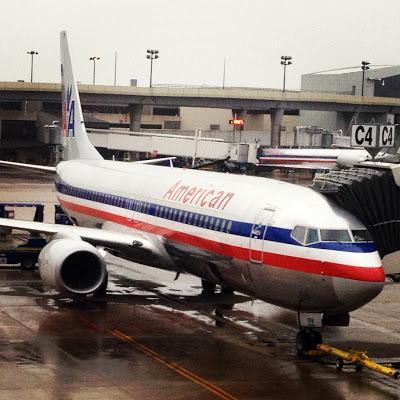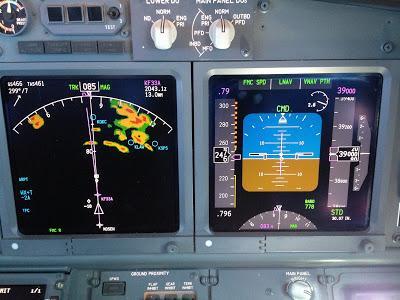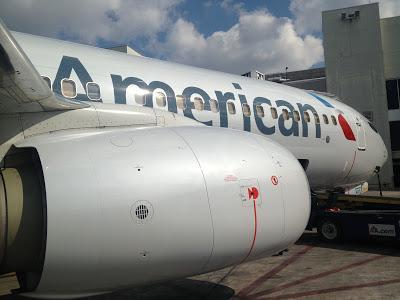After three weeks of ground school, two weeks of simulator training, two written exams, an FMS evaluation and two back to back check rides in the simulator (one on my birthday), I finally signed in for my first trip this past Wednesday morning…but training wasn't over. All the instruction I received up to this point had taken place in the classroom, a procedures trainer or the simulator. In the past, when walking through the departure lounge in uniform, I've felt like people were sizing me up as a pilot...like they could tell something about my abilities based on my physical appearance (there might actually be something to that). Wednesday was no different, except as I smiled and made eye contact with a few people about to board my aircraft, I couldn't help but wonder how they might feel if they knew this would be my first time to pilot the real thing.
It hasn't been that long since airline pilots were required to receive at least some training on the actual airplane before they were allowed to carry passengers. Typically, an instructor and two or three students would go out to the airport late in the evening to fly an airplane that had been carrying passengers all day. After a few approaches and landings in the middle of the night, bounces as we often called them, the students were all signed off and legal to fly.
Today, simulator technology has advanced to the point that pilots are routinely trained solely in flight simulation devices. On Wednesday morning, I stepped onto the airplane for the first time and safely transported 150 people who had no idea I wasn't line qualified. I was, and still am, a little wet behind the ears, but I don’t think anyone could tell. The training we receive is quite good and prepares us well for flying the line.

My first B737...sitting at the gate at DFW
I got home Friday morning after flying three days of IOE (Initial Operating Experience). During IOE, the company displaces a regularly scheduled crew member, captain and or first officer, and sends a check airman out to fly with a newly qualified pilot…that’s me! The only difference between the trip I just flew and any other, is that instead of swapping legs, I got to do most of the flying.If you've been following along, then you know that I spent the past 13 years and just over 9,000 flight hours on the MD80. I was nervous about leaving that plane for what is basically a lateral move within the company, but I needed something different and I needed a challenge. Ground and flight school certainly met that need and flying the real airplane for the first time was a challenge as well. It will take time to become as proficient on the 737 as I was on the 80…the two are starkly different…but I was immeasurably more comfortable piloting the aircraft as we made our final approach and landing on Friday than I was when we began three days earlier.
The single biggest adjustment for me has been getting used to hydraulically assisted flight controls. I've probably said this before, but flying the MD80 is like driving a Mack truck without power steering. It takes large, heavy handed control inputs to make the aircraft move in the desired direction…the same amount of force or control movement would practically turn the 737 upside down. I have learned to fly the jet with a light hand and often have only my finger tips on the controls, but old habits are hard to break and I’m still learning.
One thing about the 737 that caught me by surprise was cockpit noise…and I don’t think I’m going where you think with this one. The airplane isn't anywhere near as loud as I expected. I was a flight engineer on the 727 for a short time and I can tell you that that airplane was deafeningly loud. The 737 has the same nose as the 727 and I've always heard that the 737 had one of the loudest cockpits in the industry. Thankfully, Boeing has made a few physical improvements over the years that reduced some of the noise, but I think the most significant reason behind reduced noise levels is the fact that we don’t fly the 737 as fast as we flew the 727. Not all airlines or pilots fly the same airplane in the same way, but our procedure is to climb at 300 knots, transition to Mach .78, cruise at FMS ECON speeds and crossover to 290 knots in the descent. For an airplane with a max speed of 340 knots and .82 Mach, the slower speeds do a lot to keep the noise down. I was able to use the same ear mold headset that I used on the MD80 and had no difficulty carrying on a normal volume conversation as we flew.
There are a number of features of the next generation 737 that I've learned to love. One of my favorites is the cockpit instrumentation. Learning to interpret these screens took some work at first, but now that I've gotten used to them, I hope I never have to go back to an old “six pack” panel. The radar image in the picture below is also a major advance. Set in AUTO, the system continually scans not only left and right, but up and down as well, constantly adjusting gain and providing a much more accurate image of the weather. It even detects climbing radar returns and warns the pilots if a storm will climb into the projected flight path. Not all our jets have it and I’ll feel naked the next time I fly without it.

ND (Navigation Display) on the left. PFD (Primary Flight Display) on the right.
Another feature I've learned to love is the automatic loading of the Flight Management System (FMS) computers. With the push of a few buttons, the route, projected winds and even weight and balance data is remotely uploaded into the computer. It automatically displays V speed bugs, minimum maneuvering speeds and acceleration and cleanup altitudes. It even retrieves updated weight and balance data during taxi to fine tune the planned information loaded at the gate. This has significantly reduced my pre-flight work load and gives me time to spend on other important tasks.Of course, I've had my struggles too. All that automatic uploading is something that isn't simulated during training, so the first time I did it was on my first flight with people on board. It’s all pretty simple, but if you push the wrong button at the wrong time or out of sequence, you could end up with bad or duplicate data…and possibly a ticked off captain…neither of which sound appealing to me.
Landing the airplane has also been an adjustment. I was proud of the fact that I could consistently land the MD80 the way you would expect from someone with so much experience on the jet. Everyone makes a rough landing every now and then, but mine were few and far between. Of the four landings I made during IOE this week, I wasn't particularly happy with any of them. None were terrible, but they didn't encourage many compliments either. I blame part of that on the fact that my instructor wanted me to experience multiple flap settings (we’re authorized to land with flaps 15, 30 or 40), so the sight picture kept changing. Also, it's a known fact that flight simulators do not land anything like the real airplane...but as Ben Franklin once said “He that is good for making excuses is seldom good for anything else.” No more excuses from me.

Sporting new paint on a flight from MIA to YYZ
I’ll have more to say about this airplane as I gain experience and learn to love it. While I miss the comfort level I enjoyed after spending so much time on the MD80, I look forward to a time when I’m equally as confident on the 737. As I've said before, I’m here for the journey...and this one is going to be a lot of fun.*********************************************************************************
If you haven't already, please visit "You Have The Airplane," a new section of AirlinePilotChatter where I am inviting others to share their stories.
I've also added my bio, entitled "My Story." Both of these pages can be accessed from the navigation bar on any page of AirlinePilotChatter.
As always, thanks for following along. Questions and comments are both appreciated and encouraged.
